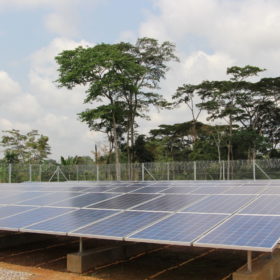
Researchers in the U.S. have deployed a phase model, inspired by thermodynamics, to total system costs and technology choices of power grids. Doing so allowed the group to make assumptions for when all renewables powered microgrids become the most economically viable option.
On islands, remote regions, or those with high demand for resilience, microgrids could become relevant competitors to large utility operated grids. By virtue of their limited size, these grids usually are more expensive in total system costs than macrogrids. On the flip side, they are also more agile in terms of technology choice, as less infrastructure must be changed.
With this in mind, a group led by the North Carolina Clean Energy Center, Golisano Institute for Sustainability, and the Department for Public Policy Rochester, have examined how cost reductions will influence system design in The nonlinear shift to renewable microgrids: Phase transitions in electricity systems which appeared in the International Journal of Energy Research.
In analyzing the nonlinear shifts from one system design to another, for example, deploying primarily diesel generators to mostly PV and storage, the researchers took a page out of physicist's books. They determined that changing from one technology to another marks a phase shift, much like water changes its phase depending on temperature from solid to liquid to gas.
Instead of phase transitions from liquid to solid depending on temperature and pressure, the grid’s phase is defined by the technologies deployed as a function of external technology prices.
“In place of the equilibrium phase minimizing free energy, the equilibrium microgrid is the design that minimizes system costs,” the paper reads. “In physical systems, phase transitions occur when the free energy becomes non-analytic (some derivative does not exist) for specific values of an external variable (such as temperature).”
In other words, if solar PV systems and battery storage assets are very costly, the least-cost and thus most prevalent microgrid approach would be diesel generators. To determine how much cheaper PV and batteries have to become to let the preference flip in favor of renewables, the researchers considered two demand profiles — Rochester, New York in the U.S., and one in Mogadishu, Somalia. The team used average load profiles for commercial and residential users from both regions sourced from HOMER pro software.
Then they set the lifetime of the microgrids at 25 years. By creating an equation with a core objective of minimizing total system cost as a function of hourly demand around the year and Capex to meet that demand, the researchers can determine which are the most promising technology combinations under various scenarios.
This equation was then fed to software which repeatedly calculated the optimized least-cost microgrid. The group states that it repeated the optimization around 79,000 times, to include different combinations of solar and battery prices, changing the variables for Capex each time.
Five phases describe the various technology choices that can feasibly be made, which excludes PV-only and storage-only systems. The result is an overview of which technology prices favor which technology choice. The boundaries denote where an optimized system changes its phase by adding or removing a technology.
For example, if the costs for storage venture below $6/Wh, commercial and residential microgrids in Mogadishu and Rochester will favor a combination of diesel generators and storage. If the price for storage dips below $1/Wh, then a PV and storage microgrid becomes economically competitive with other technology choices.
At a system LCOE of $0.10/kWh, the researchers considered a microgrid to reach price parity with macrogrids in most of the U.S. Deploying their phase change model; the group determined that the promise of grid parity comes when the price of PV drops to $0.24/W, and the storage price reaches $0.072/Wh.
Another tenet the team could draw from their analysis is that whole system prices for microgrids increase their reduction rate as a function of falling technology price. However, historically, technology price reduction decelerates over time, after a certain technological maturity level has been reached.
“While it is possible to increase the utilization of a technology by lowering its costs, major increases in adoption may occur if the costs of a complementary technology are also lowered,” the team concludes. “In doing so, both technologies will see higher utilization at individually higher prices, potentially requiring lower R&D or policy support to achieve the level of adoption.”
Lastly, the scholar asserts that their phase diagrams should be taken to predict the microgrid industry that there will be no smooth transition from one technology to another. Anticipating when technology will gain the upper hand will be critical for the industry to move into markets in which the economics play out favorably and for policymakers to establish supporting policy frameworks for technology trends.
Lắp đặt điện mặt trời Khải Minh Tech
https://ift.tt/2X7bF6x
0906633505
info.khaiminhtech@gmail.com
80/39 Trần Quang Diệu, Phường 14, Quận 3
Lắp đặt điện mặt trời Khải Minh Tech
https://ift.tt/2ZH4TRU
Không có nhận xét nào:
Đăng nhận xét